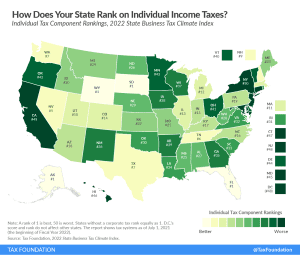Facts & Figures 2022: How Does Your State Compare?
Facts & Figures serves as a one-stop state tax data resource that compares all 50 states on over 40 measures of tax rates, collections, burdens, and more.
2 min readHow does South Dakota’s tax code compare? South Dakota does not have an individual income tax. South Dakota also does not have a corporate income tax. South Dakota has a 4.20 percent state sales tax rate and an average combined state and local sales tax rate of 6.11 percent. South Dakota has a 1.01 percent effective property tax rate on owner-occupied housing value.
South Dakota does not have an estate tax or inheritance tax. South Dakota has a 30 cents per gallon gas tax rate and a $1.53 cigarette excise tax rate. The State of South Dakota collects $4,619 in state and local tax collections per capita. South Dakota has $7,398 in state and local debt per capita and has a 100 percent funded ratio of public pension plans. Overall, South Dakota’s tax system ranks 2nd on our 2024 State Business Tax Climate Index.
Each state’s tax code is a multifaceted system with many moving parts, and South Dakota is no exception. The first step towards understanding South Dakota’s tax code is knowing the basics. How does South Dakota collect tax revenue? Click the tabs below to learn more! You can also explore our state tax maps, which are compiled from our annual publication, Facts & Figures 2024: How Does Your State Compare?

Facts & Figures serves as a one-stop state tax data resource that compares all 50 states on over 40 measures of tax rates, collections, burdens, and more.
2 min read

The FDA’s expected announcement of a national ban on menthol-flavored cigarettes and cigars with a characterizing flavor would carry significant revenue implications for both the federal government and state governments, with likely limited benefits in smoking cessation.
6 min read
Unlike other studies that look solely at tax burdens, the State Business Tax Climate Index measures how well or poorly each state structures its tax system. It is concerned with the how, not the how much, of state revenue, because there are better and worse ways to levy taxes.
4 min read
Individual income taxes are a major source of state government revenue, accounting for more than a third of state tax collections:
28 min read
While many factors influence business location and investment decisions, sales taxes are something within policymakers’ control that can have immediate impacts.
12 min read
Well-designed Net Operating Loss (NOL) provisions benefit the economy by smoothing business income, which mitigates entrepreneurial risk and helps firms survive economic downturns.
24 min read
States are unprepared for the ongoing shift to remote and flexible work arrangements, or for the industries and activities of today, to say nothing of tomorrow. In some states, moreover, existing tax provisions exacerbate the impact of high inflation and contribute to the supply chain crisis.
40 min read
The pandemic has accelerated changes in the way we live and work, making it far easier for people to move—and they have. As states work to maintain their competitive advantage, they should pay attention to where people are moving, and try to understand why.
5 min read
While there are many ways to show how much is collected in taxes by state governments, our State Business Tax Climate Index is designed to show how well states structure their tax systems and provides a road map for improvement.
169 min read